
Jelly fungi are a paraphyletic group of several heterobasidiomycete fungal orders from different classes of the subphylum Agaricomycotina: Tremellales, Dacrymycetales, Auriculariales and Sebacinales. These fungi are so named because their foliose, irregularly branched fruiting body is, or appears to be, the consistency of jelly. Actually, many are somewhat rubbery and gelatinous. When dried, jelly fungi become hard and shriveled; when exposed to water, they return to their original form.
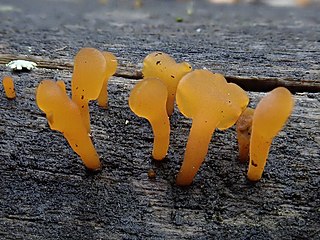
Dacryopinax spathularia is a species of fungus in the family Dacrymycetaceae. Basidiocarps are gelatinous, frequently spathulate (spoon-shaped), and grow on wood, mainly in the tropics and subtropics. The fungus is edible and is commercially cultivated for use as an additive in the food industry.
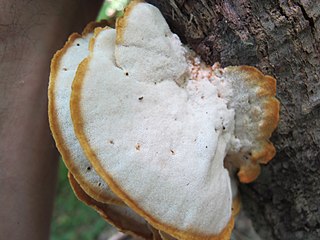
Climacodon pulcherrimus is a species of tooth fungus in the family Phanerochaetaceae. It was first described as a species of Hydnum by Miles Berkeley and Moses Ashley Curtis in 1849. T.L. Nikolajeva transferred it to its current genus Climacodon in 1962, but research published in 2007 suggests it should be placed in a different genus. It is widely distributed in subtropical and tropical areas, where it grows on decomposing hardwoods, causing a white rot.

Dacryopinax is a genus of fungi in the family Dacrymycetaceae. The genus is widespread, especially in tropical regions, and contains about 15 species. Dacryopinax was circumscribed by American mycologist George Willard Martin in 1948. A taxonomic monograph was published by McNabb (1965).

Mutinus is a genus of fungi in the family Phallaceae. The genus was first described by Elias Magnus Fries in 1849. According to the Dictionary of the Fungi, the widespread genus contains 12 species.

Cyptotrama asprata, commonly known as the golden-scruffy collybia or spiny woodknight is a saprobic species of mushroom in the family Physalacriaceae. Widely distributed in tropical regions of the world, it is characterized by the bright orange to yellow cap that in young specimens is covered with tufts of fibrils resembling small spikes. This fungus has had a varied taxonomical history, having been placed in fourteen genera before finally settling in Cyptotrama. This species is differentiated from several other similar members of genus Cyptotrama by variations in cap color, and spore size and shape.

Mutinus elegans, commonly known as the elegant stinkhorn, the dog stinkhorn, the headless stinkhorn, or the devil's dipstick, is a species of fungus in the Phallaceae (stinkhorn) family. A saprobic species, it is typically found growing on the ground singly or in small groups on woody debris or leaf litter, during summer and autumn in Japan, Europe, and eastern North America. The fruit body begins its development in an "egg" form, resembling somewhat a puffball partially submerged in the ground. As the fungus matures, a slender orange to pink colored stalk emerges that tapers evenly to a pointed tip. The stalk is covered with a foul-smelling slimy green spore mass on the upper third of its length. Flies and other insects feed upon the slime which contains the spores, assisting in their dispersal. Due to their repellent odor, mature specimens are not generally considered edible, although there are reports of the immature "eggs" being consumed. In the laboratory, Mutinus elegans has been shown to inhibit the growth of several microorganisms that can be pathogenic to humans.
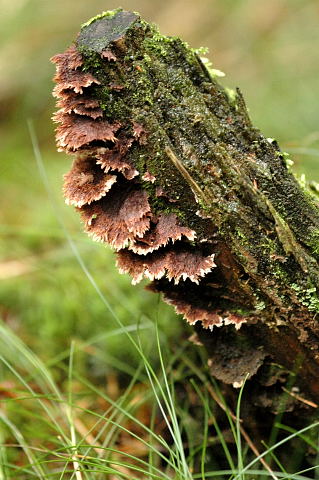
Thelephora is a genus of fungi in the family Thelephoraceae. The genus has a widespread distribution and contains about 50 species. Fruit bodies of species are leathery, usually brownish at maturity, and range in shape from coral-like tufts to having distinct caps. Almost all species in the genus are thought to be inedible, but Thelephora ganbajun is a gourmet fungus in Yunnan province of southwest China.
Glaziellaceae is a family of fungi in the order Pezizales that contains the single monotypic genus Glaziella. The type species Glaziella vesiculosa, originally collected in Cuba, was referred to the genus Xylaria by Miles Joseph Berkeley and Moses Ashley Curtis in 1869. A decade later, Berkeley circumscribed the genus Glaziella to contain a specimen collected in Brazil, apparently forgetting that he had earlier named it Xylaria aurantiaca.

Cymatoderma caperatum is a fungus species in the family Meruliaceae. It was originally described in 1849 as a species of Thelephora by Miles Joseph Berkeley and Camille Montagne. Derek Reid transferred it to Cymatoderma in 1956.
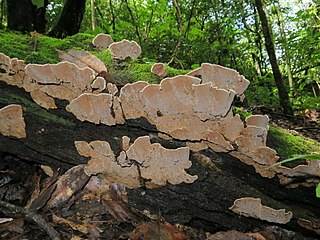
Xylobolus subpileatus is a widely distributed species of crust fungus in the family Stereaceae. It was first described scientifically in 1849 by Miles Joseph Berkeley and Moses Ashley Curtis, who considered the fungus a species of Stereum closely related to but distinct from Stereum rugosum. The original collections were made from specimens growing on dead trunks in the United States of Ohio and South Carolina. Xylobolus subpileatus was given its current name by French mycologist Jacques Boidin when he transferred it to the genus Xylobolus in 1958.
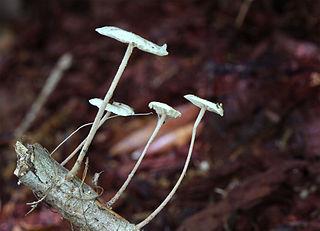
Mycetinis opacus is a species of agaric fungus first described in 1849 by Miles Joseph Berkeley and Moses Ashley Curtis as Marasmius opacus. Andrew Wilson and Dennis Desjardin transferred it to Mycetinis in 2005.
Cribraria elegans is a species of slime molds. It is found in the United States, Europe and Japan.
Uromyces elegans is a species of rust fungi in the family Pucciniaceae.
Cerocorticium molle is a species of crust fungus in the family Meruliaceae.











